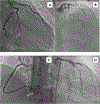FMD and SCAD: Sex-Biased Arterial Diseases With Clinical and Genetic Pleiotropy
- PMID: 34110898
- PMCID: PMC8369814
- DOI: 10.1161/CIRCRESAHA.121.318300
FMD and SCAD: Sex-Biased Arterial Diseases With Clinical and Genetic Pleiotropy
Abstract
Multifocal fibromuscular dysplasia (FMD) and spontaneous coronary artery dissection are both sex-biased diseases disproportionately affecting women over men in a 9:1 ratio. Traditionally known in the context of renovascular hypertension, recent advances in knowledge about FMD have demonstrated that FMD is a systemic arteriopathy presenting as arterial stenosis, aneurysm, and dissection in virtually any arterial bed. FMD is also characterized by major cardiovascular presentations including hypertension, stroke, and myocardial infarction. Similar to FMD, spontaneous coronary artery dissection is associated with a high prevalence of extracoronary vascular abnormalities, including FMD, aneurysm, and extracoronary dissection, and recent studies have also found genetic associations between the two diseases. This review will summarize the relationship between FMD and spontaneous coronary artery dissection with a focus on common clinical associations, histopathologic mechanisms, genetic susceptibilities, and the biology of these diseases. The current status of disease models and critical future research directions will also be addressed.
Keywords: aneurysm; biology; fibromuscular dysplasia; genetics; prevalence.
Figures






Similar articles
-
Prevalence and Disease Spectrum of Extracoronary Arterial Abnormalities in Spontaneous Coronary Artery Dissection.JAMA Cardiol. 2022 Feb 1;7(2):159-166. doi: 10.1001/jamacardio.2021.4690. JAMA Cardiol. 2022. PMID: 34817541 Free PMC article.
-
Prevalence of extracoronary vascular abnormalities and fibromuscular dysplasia in patients with spontaneous coronary artery dissection.Am J Cardiol. 2015 Jun 15;115(12):1672-7. doi: 10.1016/j.amjcard.2015.03.011. Epub 2015 Mar 23. Am J Cardiol. 2015. PMID: 25929580
-
Case reports of coronary fibromuscular dysplasia and spontaneous coronary artery dissections.Catheter Cardiovasc Interv. 2019 Mar 1;93(4):631-634. doi: 10.1002/ccd.27982. Epub 2018 Nov 23. Catheter Cardiovasc Interv. 2019. PMID: 30467965
-
Fibromuscular dysplasia of cervicocephalic arteries: Prevalence of multisite involvement and prognosis.Rev Neurol (Paris). 2015 Sep;171(8-9):616-23. doi: 10.1016/j.neurol.2015.02.011. Epub 2015 Apr 7. Rev Neurol (Paris). 2015. PMID: 25857462 Review.
-
Spontaneous coronary artery dissection (SCAD): The underdiagnosed cardiac condition that plagues women.Trends Cardiovasc Med. 2018 Jul;28(5):340-345. doi: 10.1016/j.tcm.2017.12.004. Epub 2017 Dec 11. Trends Cardiovasc Med. 2018. PMID: 29275928 Review.
Cited by
-
Spontaneous Coronary Artery Dissection in Clinical Practice: Pathophysiology and Therapeutic Approaches.Medicina (Kaunas). 2024 Jan 26;60(2):217. doi: 10.3390/medicina60020217. Medicina (Kaunas). 2024. PMID: 38399505 Free PMC article. Review.
-
Editorial: Case reports in hypertension: 2022.Front Cardiovasc Med. 2023 May 22;10:1210740. doi: 10.3389/fcvm.2023.1210740. eCollection 2023. Front Cardiovasc Med. 2023. PMID: 37283575 Free PMC article. No abstract available.
-
Cross-Ancestry Associations of Spontaneous Coronary Artery Dissection Genetic Risk With Coronary Atherosclerosis and Migraine Headache.J Am Heart Assoc. 2025 May 20;14(10):e036525. doi: 10.1161/JAHA.124.036525. Epub 2025 May 13. J Am Heart Assoc. 2025. PMID: 40357661 Free PMC article.
-
Spontaneous Coronary Artery Dissection: A Narrative Review of Epidemiology and Public Health Implications.Medicina (Kaunas). 2025 Apr 1;61(4):650. doi: 10.3390/medicina61040650. Medicina (Kaunas). 2025. PMID: 40282941 Free PMC article. Review.
-
Spontaneous coronary artery dissection: a case series illustrating current challenges in diagnosis and treatment.Future Cardiol. 2024;20(7-8):369-376. doi: 10.1080/14796678.2024.2355808. Epub 2024 Jun 7. Future Cardiol. 2024. PMID: 39115442 Free PMC article.
References
-
- Gornik HL, Persu A, Adlam D et al.First International Consensus on the diagnosis and management of fibromuscular dysplasia. Vascular medicine. 2019;24:164–189. - PubMed
-
- Kadian-Dodov D, Gornik HL, Gu X, Froehlich J, et al.Dissection and Aneurysm in Patients With Fibromuscular Dysplasia: Findings From the U.S. Registry for FMD. J Am Coll Cardiol. 2016;68:176–85. - PubMed
-
- Pappaccogli M, Di Monaco S, Warchol-Celinska E et al., The European/International Fibromuscular Dysplasia Registry and Initiative (Feiri)- Clinical Phenotypes and Their Predictors Based on a Cohort of One Thousand Patients. Cardiovasc Res. 2020. - PubMed
-
- Olin JW, Gornik HL, Bacharach JM et al., American Heart Association Council on Peripheral Vascular D, American Heart Association Council on Clinical C, American Heart Association Council on Cardiopulmonary CCP, Resuscitation, American Heart Association Council on Cardiovascular Disease in the Y, American Heart Association Council on Cardiovascular R, Intervention, American Heart Association Council on E, Prevention, American Heart Association Council on Functional G, Translational B, American Heart Association Council for High Blood Pressure R, American Heart Association Council on the Kidney in Cardiovascular D and American Heart Association Stroke C. Fibromuscular dysplasia: state of the science and critical unanswered questions: a scientific statement from the American Heart Association. Circulation. 2014;129:1048–78. - PubMed
Publication types
MeSH terms
Supplementary concepts
Grants and funding
LinkOut - more resources
Full Text Sources
Medical

